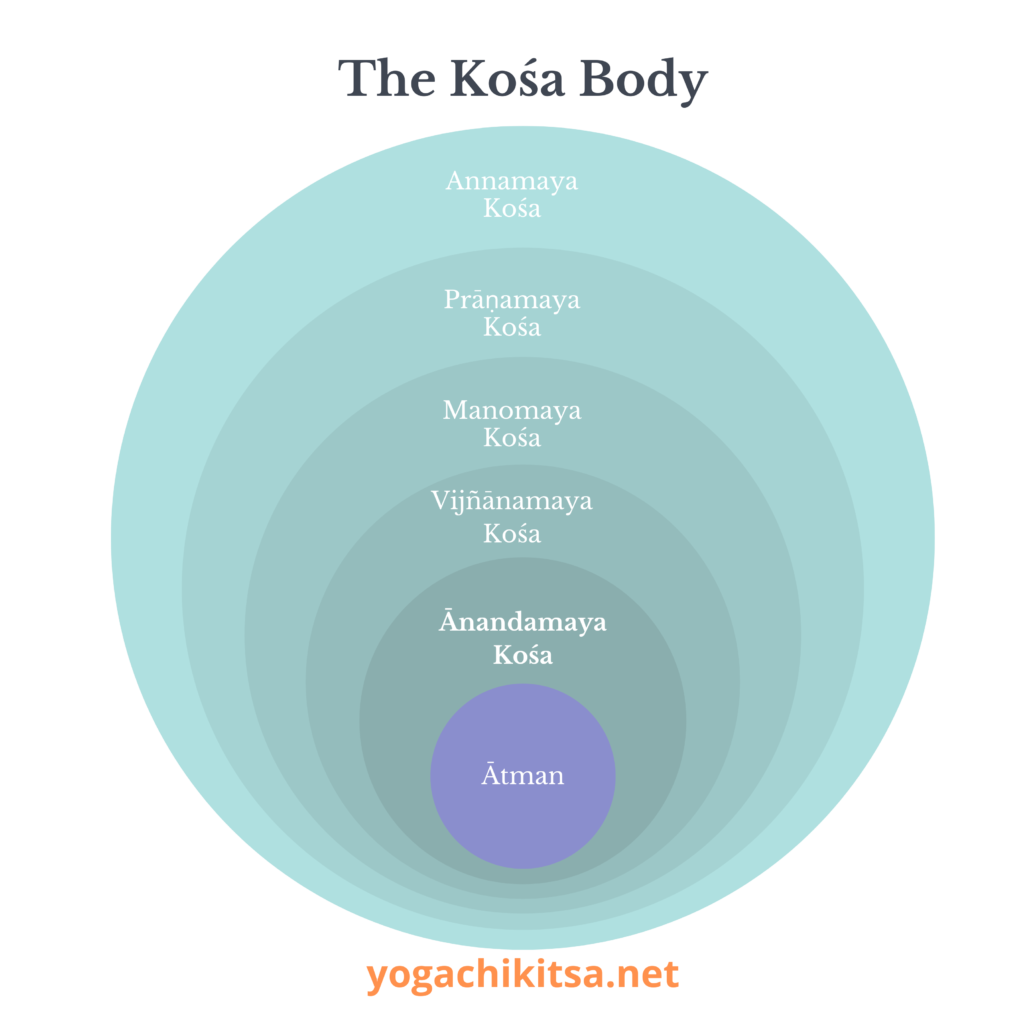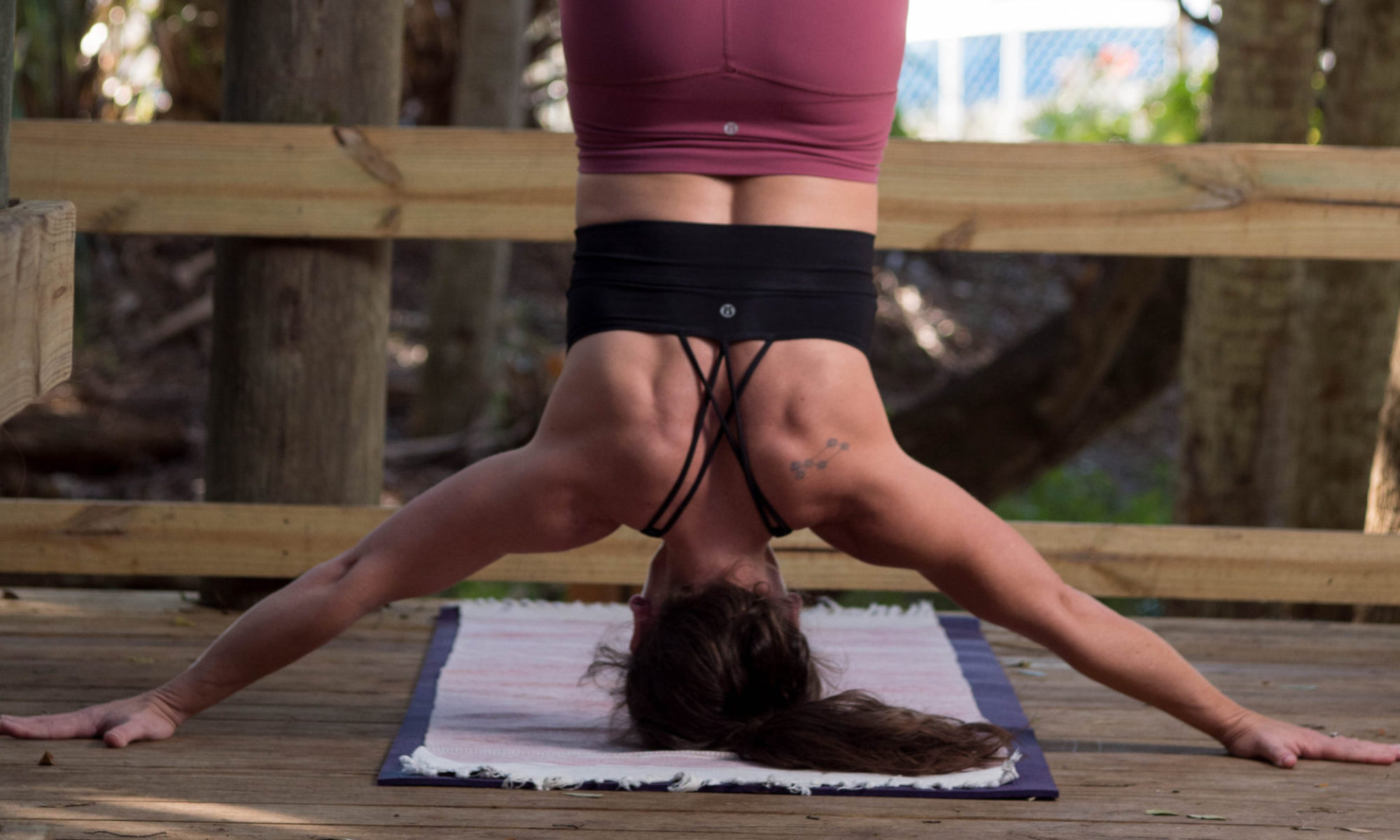According to yogic philosophy (originally taught in the Taittirīya Upaniṣad), the human framework is comprised of five bodies or sheaths. These account for the different aspects/dimensions of human existence. There is the physical body, energetic body and the mental body. The mental body can be broken down further, divided into our instinctual mind, our emotional mind and our intuitive mind. Within these layers, the Ātman, the divine, the light within, God is able to experience reality. If we are using our yoga practice as a tool to connect to this God within, we must first heal and align the layers surrounding the Ātman in order to then be able to connect with that brilliant shining light of the Self within.
From the view of yoga, our experience as humans is quite intricate and extensive. We learn that at our core, at our center there is a spark or perfect divinity – the ātman – and thus, we as humans are spiritual beings, living and interacting in a material world and equipped with:
- An energy supply
- A sensory/perceptual system to detect activities in the physical world
- A sense of ‘I’-ness
- Memory
- A cognitive (planning and thinking) mechanism to assess input and to decide on behavior
- An affective (motivational, emotional and feeling) mechanism to activate behavior
- Organs of action to approach/avoid the outside world
This is a clear and concise description of the human entity as an autonomous spiritual consciousness. This consciousness is independent of the physical body and using the mind/body complex as a means of interacting with the world.

The five sheaths function together to form an integral whole, and the work we do to balance and heal one layer will impact all the other layers. Additionally, all experiences: trauma, injury, exertion, work, etc. will impact all the layers of the human.
Pancha Kośa – The Five Sheaths – the ‘Ātman’ experiences reality within these five sheaths of the human existence
- Annamaya Kośa – physical body
- Prāṇamaya Kośa – energetic body
- Manomaya Kośa – instinctive mind
- Vijñānamaya Kośa – intuitive and altruistic mind
- Ānandamaya Kośa – transcendental mind
Annamaya Kośa
- The first aspect / level of experience is the physical body – MATTER
- This is the grossest level of experience and is referred to as the food body – dependent on food, water, air & Prāṇa
- The material layer of our human experience and the vehicle through which we navigate and interact with the world around us
- A physical body that is healthy and properly cared for can allow us to evolve along this spiritual journey without impeding our progress
Prāṇamaya Kośa
- Second aspect / level of experience – ENERGY field
- Subtler experience than the physical body which it pervades and supports
- Energizes all of our kośa-s and is vital for life at all levels
- The location of all nāḍī system, cakra system and five vāyu
Manomaya Kośa
- Third aspect / level of experience is the mental dimension – MIND
- This is the conscious mind
- This is said to hold Annamaya and Prāṇamaya Kośas together as an integrated whole
- Is a bridge between the outer and the inner worlds and give us the ability to take information in from the outside world and analyze that information to form ideas and conclusions about our world and existence.
- This is the part of the brain that is more instinctual, focused on satisfying the basic instinctual needs of food, protection, finding a mate and nurturing the offspring
- Acts in response to input from our senses (sight, hearing, smell, taste and touch)
- Consists of four parts constantly interacting with each other to receive and process information from the outside world:
- Instinctive mind (manas) – The manas makes sense of the world as we are experiencing it. Asks the questions ‘What is this?’ ‘Is it good or bad for me?’ ‘Will it hurt me?’ ‘Is this food?’ ‘Is this a potential mate?’ Without training to respond differently, the manas will always be responding to ‘that out there’ and will instinctively respond with ’fight, flight or friendship’
- Sense of ‘I’-ness (ahamkara) – This sense of self sets us apart from the outside world. This is useful in being able to protect and benefit from the outside world. The ahamkara seperates ‘me’ from ‘that.’
- Memory (citta) – A data bank of our past encounters and experiences. This information gives us tools to know how to respond in ‘this’ situation. When the manas receives information from the outside world and asks ‘What is it?’ Manas is calling on citta to determine ‘Have I seen this before?’ The response from citta will determine fight, flight or friendship.
- The intellectual mind (buddhi) – on a basic level, buddhi helps manas reach better decisions. Buddhi also functions at the higher mental layers of the mind and can exhibit the unerring wisdom of the ānandamaya kośa (bliss body)
Vijñānamaya Kośa
- The fourth aspect / level of experience – WISDOM
- Good intellect, intuition, wisdom and higher knowledge are found here
- Relates to the subconscious and un-conscious minds
- The link between the individual and universal mind
- Inner knowledge comes to the conscious mind through this level
- We experience a higher level of citta here, and ahamkara is a sense of ‘I’-ness that is part of the ‘one’-ness which is within each of us and our feelings are no longer rooted in the instinctual ‘fight, flight or friendship’ response. We start to experience all levels of love, compassion, joy, security, accomplishment and mutually fulfilling relationships.
- When awakened, experiences of intuition grow and we start to see the underlying reality behind our appearances
- Characteristics of functioning at the Vijñānamaya level:
- Objectivity
- Acceptance
- Honest and Humorous
- Committed to meaningful work, usually for others
- Independent
- Establish deep and meaningful relationships
- Have affection for and empathy with all of humanity
- Resist conformity
- Highly creative
- Democratic intheir outlook and value the rights of others
Ānandamaya Kośa
- The fifth aspect / level of existence – BLISS
- The abode of the most subtle experiences of peace, love and ecstasy
- The closest to Ātman
- The transcendental realm
- Characteristics of functioning at the Ānandamaya level:
- Oneness with the absolute
- Vast power for good
- Cosmic love
- Omniscience
- Total communication with Universal Spirit
Ātman
- The Self
- Our Soul
- The connection to that which is where we all originated and where we all will return
Yoga can be a tool to return to balance on all levels. A return to balance is essential for one to be able to experience Self-realization, the knowledge of our true nature. As beings existing in the ever-changing realm of Prakṛti, the nature of our 5 layers is constantly in flux. Thus, yoga is a tool for us to continually re-balance from the imbalances caused by existence, actions and preconditioned patterns.
The journey and experience of balance and imbalance through the kośas is not a linear experience. And, simply because someone experiences balance and stability in a kośa in one moment, that could fall away in the next moment and return the student to an imbalanced state.
When practicing yoga postures, it can be useful to notice the signs of imbalance/balance to be able to help our students the absolute most. Knowing the signs of balanced/imbalanced will provide clues as to:
- What postures are safe/unsafe
- When a posture variation might be appropriate (deeper or softer)
- When a mental/emotional state is in need of additional support
These are just a few clues we might uncover from noticing the experience in the kośa layers within. By bringing balance to the layers of the kośa a yoga practitioner is able to notice the ways they cause suffering to themselves and others and start to change those patters.
